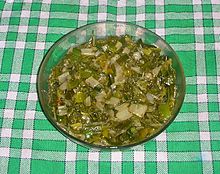- Chard
-
- "Silverbeet" redirects here. For the album by The Bats, see Silverbeet (album).
Chard 
Red chard growing at Slow Food Nation Scientific classification Kingdom: Plantae (unranked): Angiosperms (unranked): Eudicots (unranked): Core eudicots Order: Caryophyllales Family: Amaranthaceae Subfamily: Betoideae Genus: Beta Species: B. vulgaris Subspecies: B. vulgaris subsp. cicla
(L.) W.D.J.Koch [1][2]Synonyms[1][2] - Beta vulgaris var. cicla L. (basionym)
Chard (Beta vulgaris subsp. cicla),[1] is a leafy green vegetable often used in Mediterranean cooking. While the leaves are always green, chard stalks vary in color. [3] Chard has been bred to have highly nutrious leaves at the expense of the root (which is not as nutrious as the leaves). [4] Chard is, in fact, considered to be one of the healthiest vegetables available and a valuable addition to a healthy diet (not unlike other green leafy vegetables). [5] Chard has been around for centuries, however because of its similarity to beets is difficult to determine the exact evolution of the different varieties of chard [6]
Contents
Classification
Chard and the other beets are chenopods, a group which is either its own family Chenopodiaceae or a subfamily within the Amaranthaceae. Although the leaves are eaten, it is in the same group and subfamily as beetroot (garden beet), which is usually grown primarily for its edible roots. Chard is also known by its many common names such as Swiss chard,[7] silverbeet, perpetual spinach, spinach beet, crab beet, bright lights (due to the bright and vivid spring colors when they are cooked or provided as a medley of vegetables), seakale beet, and mangold and is one of the cultivated descendants of the sea beet, Beta vulgaris subsp. maritima.[8]
Etymology
The word "Swiss" was used to distinguish chard from French spinach varieties by 19th century seed catalog publishers. The chard is very popular among Mediterranean cooks. The first varieties have been traced back to Sicily.
Growth
Chard can be harvested while the leaves are young and tender, or after maturity, when they are larger and have slightly tougher stems. Raw chard is extremely perishable.
Chard has shiny, green, ribbed leaves, with stems that range from white to yellow to red, depending on the cultivar. It has a slightly bitter taste. Fresh young chard can be used raw in salads. Mature chard leaves and stalks are typically cooked (like in pizzoccheri) or sauteed; their bitterness fades with cooking, leaving a refined flavor which is more delicate than that of cooked spinach.
Cultivars of chard include green forms, such as 'Lucullus' and 'Fordhook Giant', as well as red-ribbed forms such as 'Ruby Chard' and 'Rhubarb Chard'.[8] The red-ribbed forms are very attractive in the garden, but as a rough general rule, the older green forms will tend to out-produce the colorful hybrids. 'Rainbow Chard' is a mix of other colored varieties that is often mistaken for a variety unto itself.
Chard is used in a variety of cultures around the world, including Arab cuisine.
All parts of the chard plant contain oxalic acid.
Nutritional content
Chard, swiss, cooked, boiled, drained, without salt Nutritional value per 100 g (3.5 oz) Energy 84 kJ (20 kcal) Carbohydrates 4.13 - Sugars 1.10 - Dietary fiber 2.1 Fat 0.08 Protein 1.88 Water 92.65 Alcohol 0 Caffeine 0 Vitamin A 6124 IU - beta-carotene 3652 μg (34%) - lutein and zeaxanthin 11015 μg Thiamine (vit. B1) 0.034 mg (3%) Riboflavin (vit. B2) 0.086 mg (7%) Niacin (vit. B3) 0.360 mg (2%) Pantothenic acid (B5) 0.163 mg (3%) Vitamin B6 0.085 mg (7%) Folate (vit. B9) 9 μg (2%) Vitamin B12 0. μg (0%) Choline 28.7 mg (6%) Vitamin C 18.0 mg (22%) Vitamin D 0 μg (0%) Vitamin D 0 IU (0%) Vitamin E 1.89 mg (13%) Vitamin K 327.3 μg (312%) Calcium 58 mg (6%) Iron 2.26 mg (17%) Magnesium 86 mg (24%) Manganese 0.334 mg (16%) Phosphorus 33 mg (5%) Potassium 549 mg (12%) Sodium 179 mg (12%) Zinc 0.33 mg (3%) Percentages are relative to US recommendations for adults.
Source: USDA Nutrient DatabaseSwiss chard is high in vitamins A, K and C, with a 175 g serving containing 214%, 716%, and 53%, respectively, of the recommended daily value.[9] It is also rich in minerals, dietary fiber and protein.[10]
See also
References
- ^ a b c This plant, treated as a subspecies of Beta vulgaris, was first published in Synopsis der Deutschen und Schweizer Flora 2: 720. 1846. Its basionym isB. vulgaris var. cicla L. "Name - Beta vulgaris subsp. cicla (L.) W.D.J.Koch". Tropicos. Saint Louis, Missouri: Missouri Botanical Garden. http://www.tropicos.org/Name/7201442. Retrieved August 26, 2011. "Basionym: Beta vulgaris var. cicla L."
- ^ a b The basionym of B. vulgaris subsp. cicla (B. vulgaris var. cicla L.) was originally described and published in Species Plantarum 1: 222. 1753. "Name - Beta vulgaris var. cicla L.". Tropicos. Saint Louis, Missouri: Missouri Botanical Garden. http://www.tropicos.org/Name/7200834. Retrieved August 26, 2011. "Annotation: as "Cicla""
- ^ [1] 17 November 2011, The New York Times
- ^ [2] 17 November 2011, Wise Geek
- ^ [3] World's Healthiest Foods, George Mateljan Foundation, 17 November 2011 World's Healthiest Foods
- ^ [4] 17 November 2011 Clifford A. Wright
- ^ Characterization and biological activity of the main flavonoids from Swiss Chard (Beta vulgaris subspecies cycla). Phytomedicine: International Journal of Phytotherapy & Phytopharmacology, 01-FEB-07
- ^ a b Eat with the beet, Monty Don, 9 February 2003, The Guardian
- ^ Nutrition Facts and Analysis for Chard
- ^ Worlds Healthiest Foods
Categories:- Leaf vegetables
- Amaranthaceae
- Edible plants
- Plant common names
Wikimedia Foundation. 2010.


